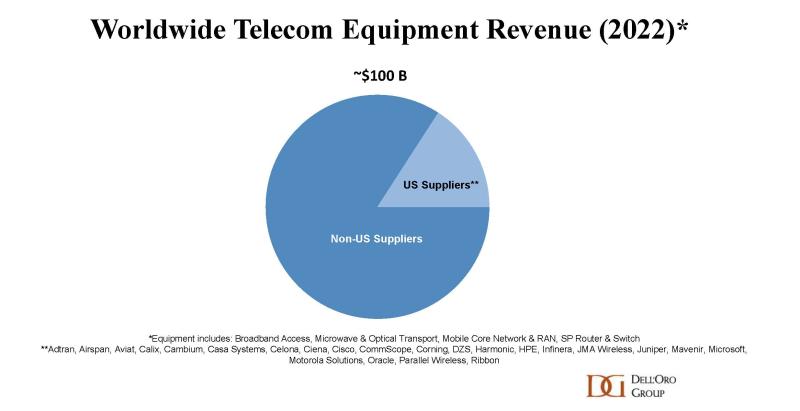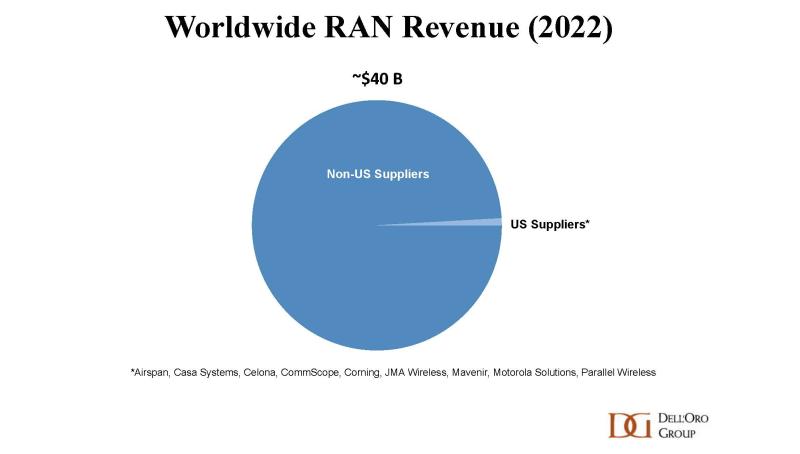
Nearly two years have passed since the Wall Street Journal wrote about U.S. suppliers upending the now ~$40 billion RAN market. We wrote about this topic last year, and the timing is right to revisit and assess how the campaign by the U.S. government to curb the rise of Huawei and improve the domestic alternatives is progressing both from a broader telecom and RAN perspective.
Let’s start with the broader ~$100 billion telecom equipment market (hardware and software for wireless and wireline equipment, excluding services). From this high level lens, the data contained in the Dell’Oro reports shows that the U.S. suppliers collectively accounted for around 16% of the global telecom equipment market in 2022, underpinned by strong presence in broadband access, optical transport and SP Routers. Not surprisingly, this global view is masking the progress to some degree. If we exclude China, we estimate that the 20+ American suppliers comprise around a fifth of the broader telecom equipment market.

On the surface, the U.S. suppliers appear to be struggling more in the RAN domain. Per the 4Q22 RAN report, the American-based vendors still accounted for less than 1% of the global RAN market in 2022. Even if we remove China, the aggregate revenue share remains in the same range.
Below the surface, however, the data is more encouraging. Notably, we estimate that the collective RAN revenues for the U.S. suppliers were up around 60% in 2022 relative to 2020, in part because of the improved entry points with open RAN.
Perhaps more importantly, near-term visibility remains favorable, and the domestic vendors are fairly optimistic about the growth prospects:
- Mavenir is targeting 30%+ growth in 2023. While the mobile core network continues to drive the lion’s share of its revenue mix, Mavenir’s 10,000+ macro-site brownfield pipeline is expected to play a pivotal role in reaching this $1 billion group revenue target for FY23.
- Celona is working with 100+ customers and has seen a 300%+ increase in the number of connected devices across its 5G installed base. The vendor is now targeting to more than double its revenues this fiscal year.
- JMA has not shared any growth objectives for its wireless business. Even so, the vendor has announced multiple DoD wins and believes its all-American team is well positioned to support advanced private 5G networks for the U.S. government.
- Verana Networks is set to work on a trial with Verizon later this year.
- Dell is planning to enter the vRAN market over the next year, allegedly.
- Airspan’s equipment and software revenue growth slowed in 2022. Still, trial activity is on the rise and Airspan remains hopeful that its 400+ private network wins will soon have a more meaningful impact on the topline.

At the same time, it is early days in this process of re-shaping the RAN. And even if global market concentration as measured by the Herfindahl-Hirschman Index (HHI) is actually trending in the right direction, vendors with smaller footprints are still trying to figure out the best near-term and long-term approaches to improve their respective RAN positions - some think that open RAN can be an entry point for brownfield macro opportunities while others believe the likelihood of winning is greater in greenfield settings (public or private).
After all, open RAN might help to open the door, but this movement does not change the fact that RAN remains a scale game and double-digit RAN revenue shares are still required to maintain competitive portfolios.
Currently, this vendor asymmetry between RAN and the broader telecom equipment market then also implies that the U.S. suppliers are actually doing rather well beyond the wireless scope. In fact, if we remove the RAN from the picture, we estimate that the U.S. vendors accounted for around a fourth of the global non-RAN telecom equipment market. Better yet, if we take it one step further and also strip out China, the data shows that the American team comprised around one third of the non-RAN telco equipment market excluding China.
In short, our assessment is that the U.S. suppliers hold a strong position in the non-RAN telecom equipment market. When it comes to RAN, however, the data shows that the American-based suppliers are moving in the right direction, especially in private wireless. But the overall progress has been slow, and it is still a long road ahead before we can establish that the U.S. suppliers are back at full speed in the broader public plus private 5G RAN game.
Stefan Pongratz is a vice president at the Dell’Oro Group. He joined Dell’Oro in 2010 after spending 10 years with the Anritsu Company. Pongratz is responsible for the firm's Radio Access Network and Telecom Capex programs and has authored advanced research reports on the wireless market assessing the impact and the market opportunity with small cells, C-RAN, 5G, IoT and CBRS.
"Industry Voices" are opinion columns written by outside contributors—often industry experts or analysts—who are invited to the conversation by FierceWireless staff. They do not necessarily represent the opinions of the editorial board.